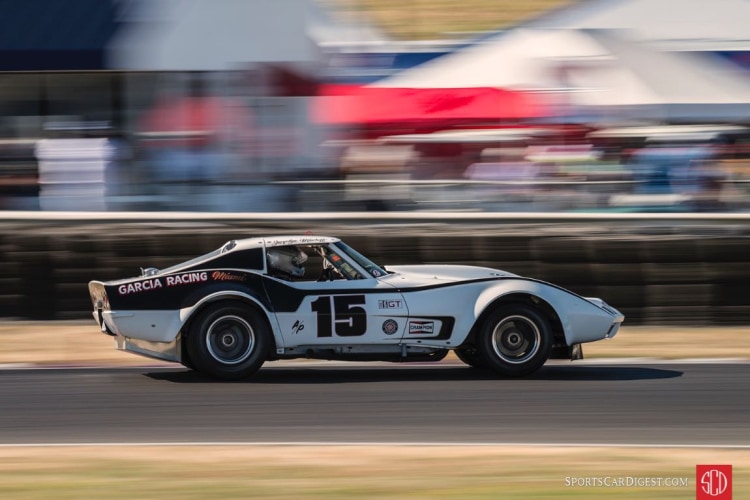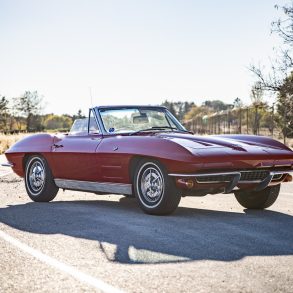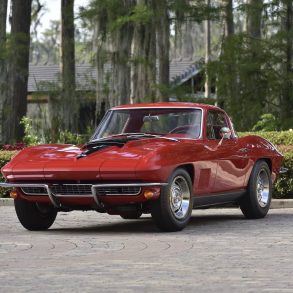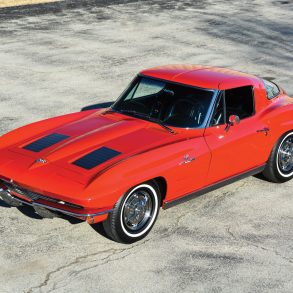In the automotive world, Corvette is a name that is synonymous with unique sportiness and dynamism. Among those automotive legends came the third generation Corvette, known as the C3 Corvette- one of the most iconic generations of them all.
Many people want to acquire the Chevrolet Corvette C3 as a classic car, loving its ease of driving with its power steering and power brakes.
Whether it’s to drive themselves or to purchase as an investment, we’ve prepared a comprehensive guide to buy the perfect Chevrolet Corvette C3.

Background: How the Chevrolet Corvette C3 Came About
Looking back at the corvette history, the C3 Corvette started life midway through the C2 production. Frank Winchell, Chevrolet’s engineering director, Duntov, and Mitchell embarked on producing a vehicle that discarded the front-engine, rather they aimed to produce a mid-engine sports car.
Duntov and Mitchell based their mid-engine design on the Mako Shark concept.
The concept of a mid-engined Corvette was abandoned due to budgetary constraints and the absence of suitable mid or rear-engine parts compatibility. Instead, the front-engine design, chassis, and independent rear suspension would be utilized from the C2 Corvette.
To take on the project, Billy Mitchell hired new designer Larry Shinoda with the Mako Shark II being the resulting concept.

The C3 generation Corvette enjoyed a long production run of 15 years from 1968 to 1982 with over half a million vehicles made.
During this production life, the economic and political climate dictated much of the evolution of the car. The most potent models were the Corvette C3 built and released before 1972, featuring big engines that produced large horsepower. Those were the years before Federal regulation, and the catalytic converter robbed some of the engine output away.
Buying a Chevrolet Corvette C3
As we mentioned above, the C3 Corvette came with a long production history and many diverse model variants made.
Before shopping around, determine from the onset what type of C3 Corvette and model year you would like to own. Corvette fans adore rare variants like the L88 (only 216 produced) and ZL1 Corvette. These unique variants may not be your style, as a daily driver may be what you are seeking.

David Sirotinsky ©2019 Courtesy of RM Sotheby’s
Whatever the reason for your purchase you will need to consider the following options:
- Rubber bumpers or chrome bumper?
- Coupe or convertible?
- Manual transmission or automatic transmission?
- Flat rear window glass or bubble rear window glass?
- How much horsepower are you looking for? Big block engine or small block engine?
Once you have an idea of what type of Vette is for you, it’s time to consider what amount of restoration to the c3 corvette you feel comfortable performing. Are you after a daily driver, project car, or Concours vehicle? Make sure you know what you are buying and it’s within your mechanical ability to restore.
Inspecting a Corvette C3 For Purchase
The Corvette C3 has been around now for decades and some vehicles will show their age. Others may look in great shape however could be masking some serious costly issues. These issues may not be obvious from a quick exterior inspection which is why we encourage prospective buyers to look over the vehicles thoroughly before making a purchase.
Here are 10 areas to look at:
1. Frame or Birdcage Rust
A common misnomer is that the C3 Corvette consists of a fiberglass body that doesn’t rust. Yes, this may be true about the body, however, the C3 Stingray frame is prone to rust.
Corrosion in the chassis and birdcage (the entire metal frame that surrounds the passenger cabin) are labor-intensive to fix, with the entire car needing to be pulled apart in some instances to repair.
You can check the condition of the birdcage underneath the door sill plates and pull the windshield pillar trim off from the inside. Another spot that is vulnerable to rust is the ‘kickup’ area just forward of the rear wheels.
2. Exterior of the Vehicle
Take the time to have a really close look around the bodywork of the car for previous damage to the vehicle. Clues to look for are uneven gaps in the body panels, mismatched paint, bumpers that are misaligned, and doors that are challenging to close.

©2019 Courtesy of RM Auctions
Examine for any cracks where the body mounts to the frame in the wheel wells.
Do the trim codes on the drivers door post match the paintwork?
Inspect the Body panels that feature ripples, stars, crazing, and cracks can be very costly to repair.
If the car your inspecting has a T-Top, inspect the latches for correct operation and examine the weatherstripping.
3. Headlights
The concealed headlights of the C3 Corvette are vacuum operated and can be prone to issues.
Inspect the headlight and ensure they are in working order. You should see both headlights open simultaneously.
Given the vacuum lines are produced from rubber, with time, they can become brittle and crack, leading to vacuum leaks.

4. Engine
You might think you know what you’re getting, but in its 15-year production history, the Chevrolet Corvette C3 had many different engine options. All of them were V8 engines, starting with a 305 cu in (5.0 L) producing 180 horsepower all the way up to a 454 cu in (7.4 L) LS6.

Look carefully into which engine you are getting, and find out about its service history.
Does the car have an original engine block and transmission? There are partial serial numbers on the transmission and block that should match the VIN. Having matching numbers is not necessary if you aren’t interested in a show car, it is just a good idea to check as matching numbers command a higher price.
5. Bumpers
Early C3 (1968-1972) had a chrome bumper both at the front and rear. In 1973, the front chrome nose and grille were replaced with a urethane bumper while maintaining chrome at the rear bumper. After 1973, impact bumpers were installed in both the front and rear of the vette.


The material used on the rubber bumpers is prone to becoming brittle and cracking over time, a labor-intensive job to replace and color-match will be required.
6. Interior
The car’s interior can give you many clues regarding the attention to detail the previous corvette owner provided your future car.
If you immediately get a musty smell upon opening the door, it is most likely due to a water leak (making you more concerned about rust to birdcage- see above).
Inspect the interior trim and confirm the trim codes on the driver’s door post match the interior trim.

Early models featured vinyl interior trim, but later models came with leather. The interior features were famously durable however areas prone to wear include the drivers and passenger seats, cracking in the center stack, and dashboard (due to prolonged sunlight exposure or significant changes in temperature).
Check the carpets are dry. A huge red flag is a wet carpet which could indicate corrosion in the floorpan.
While inside the vehicle check electricals are working, including air conditioning, AM/FM radio, windshield wipers, and the power window.
Check inside the vehicle for the optional upgrades that may come with the car, such as headrests, the steering wheel condition, and whether the tilt-telescopic steering column is operational.
7. Power Steering
Another feature you want is power steering, especially if the car engine you are getting is a big-block model. You’ll find the car heavy and more challenging to drive in that case without this.
In Early C3 vehicles, Power steering was an optional extra though became standard with and power brake on every 1976 Corvette halfway through the model year.
8. Suspension
The independent rear suspension system was carried over from the C2 Corvette and requires maintenance.
Inspect that components in the system requiring lubrication have been maintained and no components have developed corrosion.
9. Gearbox
A variety of transmissions were offered during third-generation Corvette production, including 3-speed and 4-speed manual transmission as well as 3-speed and 4-speed automatic transmission.
By the final year of the C3 production only 4-speed automatic transmission was available.

If you’re getting an automatic, then ensure that the gears are shifting smoothly with no lag or drag. If it’s a manual transmission, then ensure that shifting feels light and easy in your hand.
10. Test Drive the Car
When test driving the car, make sure it starts easily and all operating components like headlights, windscreen washers, and instrument panels are working. While driving, excessive wind noise could indicate the weather strips may need replacing.
Test the clutch, and ensure if you are looking at a manual transmission vehicle it doesn’t pop out of gear.
Also test the brakes, making sure it feels keen and powerful. The C3 has disc brakes on all four wheels and is prone to corrosion with time leading to potential failure.
How much is a Corvette C3 worth?
The value of the Corvette C3 varies depending on whether you are looking at a classic corvette like the L88, a collector edition C3, or just a daily driver. You may buy a fair condition 1982 C3 corvette coupe for $8000; however, a Concours condition 1968 Convertible L88 will fetch over $500,000.
Here are some examples of model years and the price you can expect to pay (prices are in USD):
1968 Chevrolet Corvette Coupe V8 327cid/300 HP 4BBL
| Condition | Price |
|---|---|
| Concours | $51,500 |
| Excellent | $36,800 |
| Good | $20,700 |
| Fair | $12,100 |
1968 Chevrolet Corvette Convertible 8-cyl. 327cid/300 Horsepower 4BBL
| Condition | Price |
|---|---|
| Concours | $59,900 |
| Excellent | $44,400 |
| Good | $27,700 |
| Fair | $15,100 |
1974 Chevrolet Corvette Coupe V8 454cid/270 Horsepower 4BBL LS4
| Condition | Price |
|---|---|
| Concours | $39,300 |
| Excellent | $26,800 |
| Good | $15,600 |
| Fair | $10,000 |
1982 Chevrolet Corvette Collector Edition Coupe V8 350cid/200 Horsepower
| Condition | Price |
|---|---|
| Concours | $34,000 |
| Excellent | $20,300 |
| Good | $12,400 |
| Fair | $8,100 |
With the demand for these cars growing, now is a great time to snap up a bargain. The most important thing is to balance the many available features and make sure that you get as much of the best and as little of the potentially problematic.
It’s no secret that Corvettes can be difficult cars to manage and run. They are stunning to look at and fun to drive, but older cars come with different risks. Thorough inspections of all the areas we mentioned above are an absolute must for anyone seriously considering a Corvette C3.
Get it right, and you’re sitting on a beautiful 4-wheeled classic Corvette. Get it wrong, and you’re looking at an expensive mechanical liability. Don’t skip any of the checks to ensure you have a road map to Corvette C3 success.










